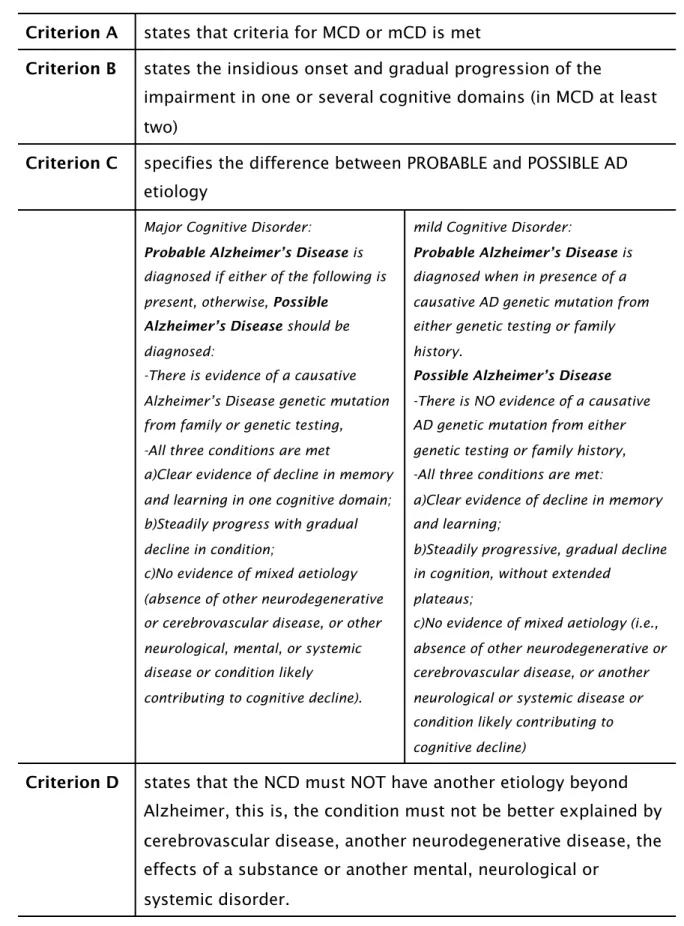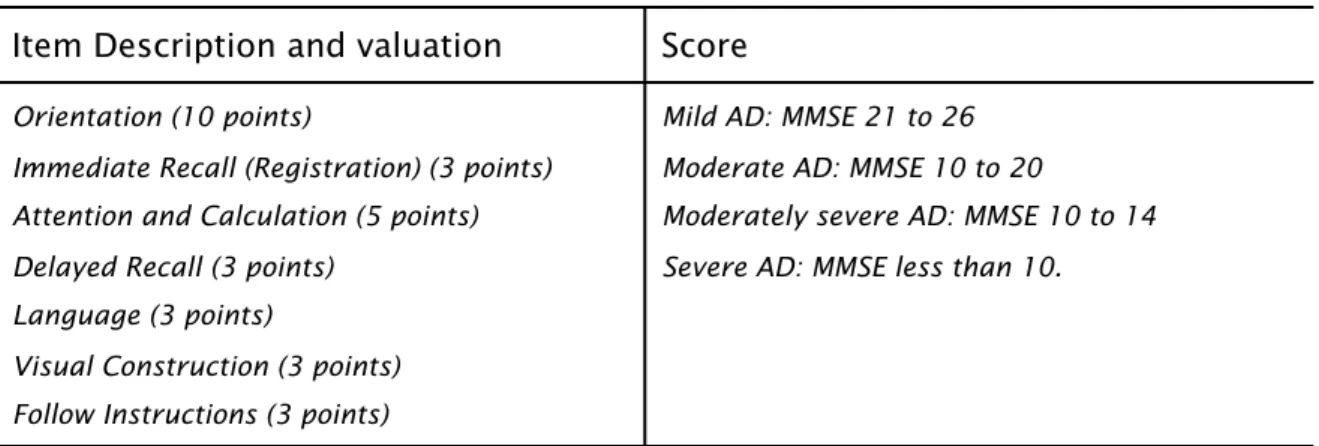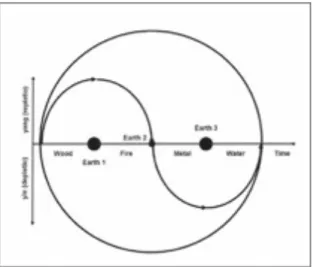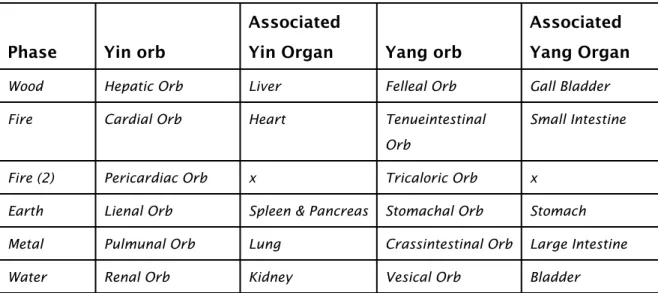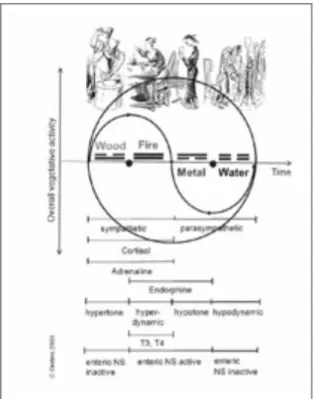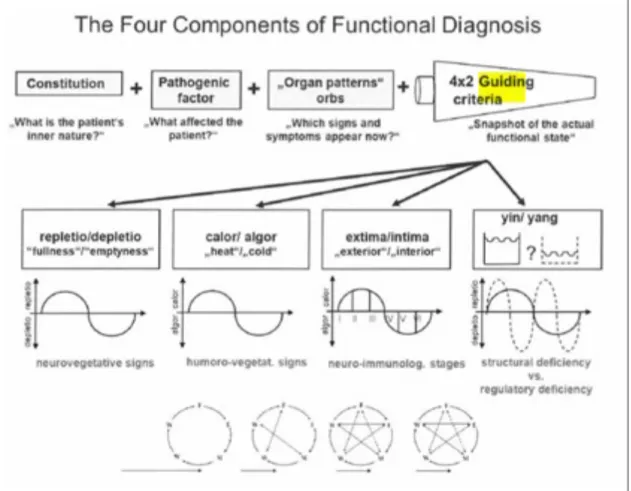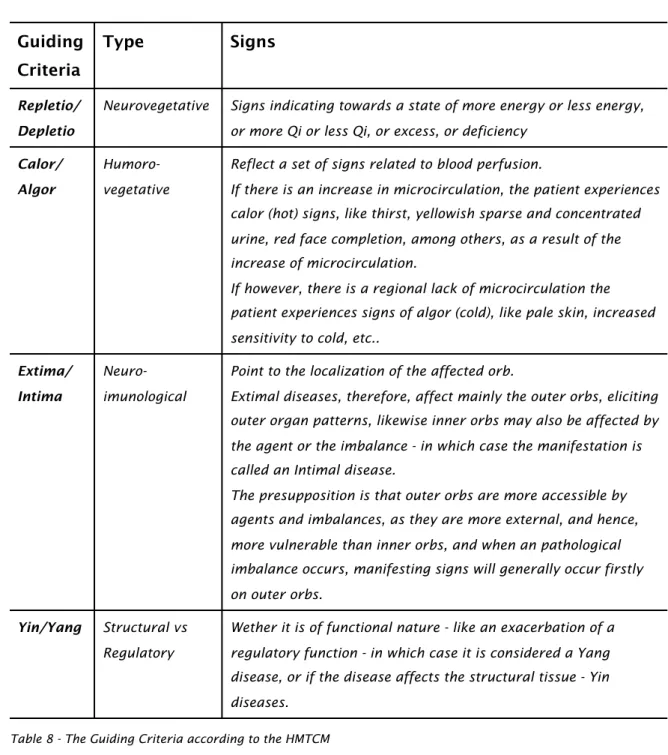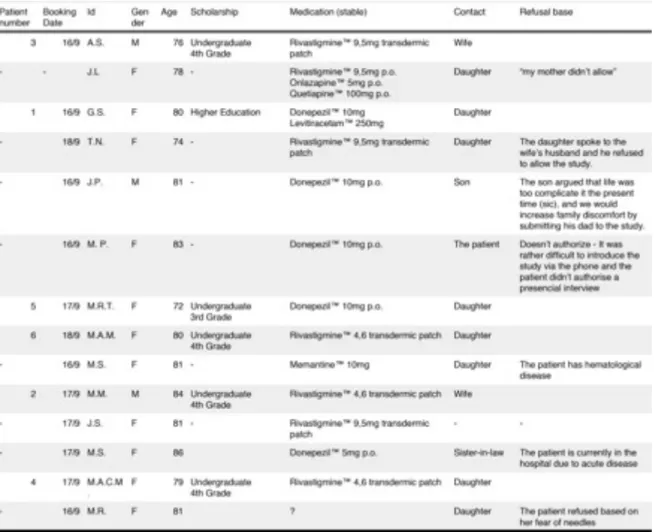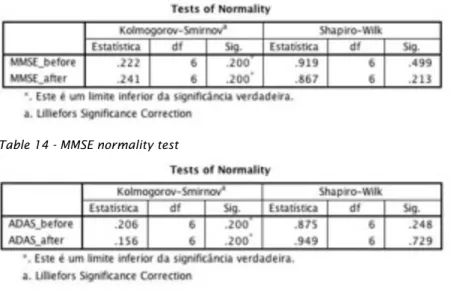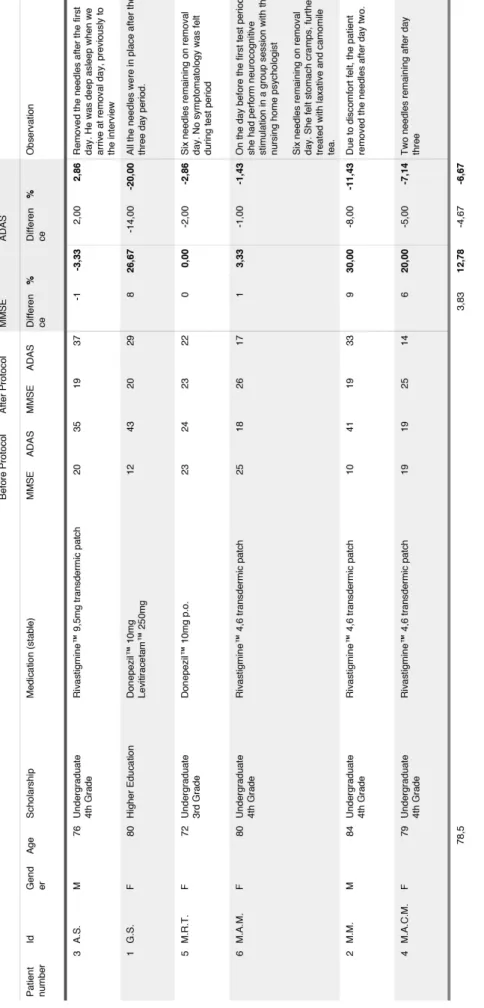EFFECT OF HEIDELBERG SCALP
ACUPUNCTURE ON THE COGNITIVE
FUNCTION OF MILD TO MODERATE
ALZHEIMER’S DISEASE PATIENTS
-A PRELIMINARY STUDY
Carlos Miguel Soares dos Reis
Dissertação de Mestrado em Medicina Tradicional Chinesa
Carlos Miguel Soares dos Reis
EFFECT OF HEIDELBERG SCALP ACUPUNCTURE (HSA) ON THE
COGNITIVE FUNCTION OF MILD TO MODERATE ALZHEIMER’S
DISEASE PATIENTS
-A PRELIMINARY STUDY
Dissertação de Candidatura ao grau de Mestre
em Medicina Tradicional Chinesa, submetida
ao Instituto de Ciências Biomédicas Abel
Salazar da Universidade do Porto
Orientador
Doutor Henry Johannes Greten
Categoria - Professor Associado
Instituto de Ciências Biomédicas Abel Salazar
Co-Orientador
Dr. Pedro Carneiro
Co-Orientador
Mestre Dr. Nuno Correia
Acknowledgments
to Professors Johannes Greten and Jorge Machado for their resilience in the defense of Traditional Chinese Medicine;to doctors Nuno Correia and Pedro Carneiro, and to Master Maria João Santos, for having accepted to be a part of this project;
to every teacher that have inspired my academic journey until the present, and to all of those that will continue to do so in the future;
to all of the good friends which whom I’ve had the privilege to share this path with - thank you Mário and Christiane;
and finally,
a special thanks to my dearest Tatiana, for your love, support, friendship and strength - you’ve been my beacon these last few years…
Resumo
EnquadramentoCerca de 2 a 8% dos indivíduos acima dos 60 anos de idade sofrem de alguma forma de Demência, de entre as quais a Doença de Alzheimer (DA) é a mais
comum. Até ao presente, a doença não tem cura, exercendo uma enorme pressão sobre os custos dos serviços sociais de saúde de cada país - é a sexta maior causa de morte nos Estados Unidos e representa mais da metade de todos os casos de demência, que se estimam vir quadruplicar nas próximas quatro décadas.
Objectivos
A Acupunctura Craniana de Heidelberg (ACH) é um novo sistema somatotópico de acupunctura, tendo por base a existência de correlações entre pontos específicos localizados no escalpe, funções fisiológicas e regiões anatómicas. Com suporte em experiências anteriores, propomos desenvolver um protocolo de estudo, envolvendo o tratamento de pacientes portadores da Doença de Alzheimer,
através da ACH, avaliando o potencial benefício em termos da evolução da função cognitiva, medida através do recurso a testes psicométricos, nomeadamente a Avaliação Breve do Estado Mental (ABEM) e à vertente cognitiva da Escala de Avaliação da Doença de Alzheimer (EADA).
Propomos no final uma abordagem metodológica para comparar a eficácia da terapia combinada (ACH + terapia farmacológica) vs terapia farmacológica, na função cognitiva de doentes de Alzheimer.
Métodos
Depois de obtido parecer positivo por parte da Comissão de Ética do ICBAS-UP, foram contactados catorze pacientes diagnosticados com DA por um neurologista independente. Seis desses sujeitos (idade média de 78.5 anos), aceitaram o
convite para fazer parte de um estudo preliminar e, após o consentimento informado, foram aplicadas e retidas por um período de 3 dias, sete agulhas permanentes (gold) nos apelidados sete chakras. Como parte dos critérios de inclusão, foi solicitado ao seu médico responsável a não alteração da medicação durante o período de experiência.
Resultados
Após administração da ACH, verificámos melhorias nos resultados de testes em cinco dos seis pacientes que incorporaram o estudo. No que respeita à ABEM o aumento médio foi de 3,83 pontos (4.36dp) e na EADA-cog, a melhoria está reflectida na redução média verificada de 4,67 pontos (5.72dp). Não foram observadas diferenças estatisticamente significativas quando comparadas as médias obtidas antes e depois da condição de tratamento. Os dados permitiram ainda a estimativa do tamanho da amostra, que neste caso deverá ser n>289.
Discussão
Apesar da ausência de significância estatística, o que em nossa opinião se fica a dever ao reduzido tamanho da amostra e aos elevados desvios-padrão verificados (algo expectável para a patologia), no presente estudo foram observadas
melhorias individuais e incrementos médios impressionantes para ambos os testes.
A Acupunctura Craniana de Heidelberg parece promissora na reversão do déficit cognitivo dos pacientes com DA. O eventual mecanismo de acção da ACH na DA poderá estar relacionado com o aumento da microcirculação em algumas zonas cerebrais, no entanto, este raciocínio é puramente especulativo e deverá ser objecto de investigações futuras. Após análise estatística e qualitativa dos dados, propomos uma metodologia para um futuro ensaio clínico.
Keywords: Acupunctura Craniana de Heidelberg; Doença de Alzheimer; Avaliação Breve do Estado Mental; Escala de Avaliação da Doença de Alzheimer - sub-escala cognitiva; Acupunctura; Medicina Tradicional Chinesa; micro Acupunctura
Abstract
BackgroundIn each country 2 to 8% of the individuals above 60 years old are expected to suffer from any form of the dementia, from which Alzheimer’s Disease is the most common form. This medical condition for which there is still no cure, puts a considerable amount of pressure on national health care systems facing
immensely huge health care costs. The disease is already the sixth leading cause of death in the United States and it represents more than half of all Dementia cases, which are expected to quadruple over the next four decades.
Objectives
Heidelberg Scalp Acupuncture (HSA) is a novel somatotopic system of
Acupuncture developed on the basis of existing correlations between specific skull acupoints, physiological functions and anatomical regions. Due to some positive personal experience with this technique, we are interested in finding whether it is possible to develop a study protocol to treat Alzheimer’s Disease by HSA, and to measure the potential clinical outcome using psychometric tests - the Mini Mental State Examination (MMSE) and Alzheimer’s Disease Assessment Scale - cognitive subscale (ADAS-cog).
We further propose a methodological approach to compare the efficacy of a combined therapy (HSA and pharmacological treatment) versus pharmacological treatment alone, on the cognitive function of AD patients.
Methods
After obtaining positive feedback from the ICBAS-UP Ethical Committee, fourteen patients diagnosed with AD by an independent Neurologist were contacted. Six of these subjects (mean age 78.5 years), showed willingness to be part of a
preliminary study and after informed consent, HSA was applied. Permanent scalp acupuncture gold needles were retained for a three day period in the so called
seven chakras with no change in the patients medication occurring during the
test period (part of the eligibility criteria).
Results
Out of the six patients that took part in the experiment, five have shown better values in both tests after HSA. Regarding MMSE, average increase was 3.83 points
(4.36sd) and on ADAS-cog, improvement was reflected by an average decrease of 4.67 points (5.72sd). No statistical differences were found before and after the treatment condition. The data further allowed the estimation of the sample size, which in this case should be n>289.
Discussion
Despite the absence of statistical significance, which in our opinion is due to the small sample size and high standard deviations (which is expected in this
disease), we measured impressive individual and average improvements in MMSE and ADAS-cog.
Heidelberg Scalp Acupuncture showed promising results on the reversion of the cognitive deficit felt by AD patients. The mechanism by which this potential effect may take place could be an increase microcirculation within certain areas of the brain, although this remains speculative. After statistical analysis and scrutiny of recovered insights, a methodology for a future clinical trial is proposed.
Keywords: Heidelberg Scalp Acupuncture; Alzheimer’s Disease; Mini Mental State Examination; Alzheimer’s Disease Assessment Scale - cognitive subscale;
Contents
INTRODUCTION 1
ALZHEIMER’S DISEASE 6
DIAGNOSIS 7
Diagnostic Markers & Biological evidences 12
Risk and prognostic factors 13
Disease Course and Pharmacological Treatment 14
SCALES AND ASSESSMENT 16
Tests Description 18
Pharmacological Treatment and Neuropsychological Scales 22
TRADITIONAL CHINESE MEDICINE 24
BACKGROUND 25
TCM Definition 26
Theory of Yin and Yang 27
The Theory of the Five Movements (Phases) 28
Theory of Qi and the Conduit System 32
TCM DIAGNOSE 34
ACUPUNCTURE 38
Acupuncture Mechanism 38
Microsystems Acupuncture 40
TCM & NEUROLOGY 46
TCM on Dementia and Current State of the Art 48
STUDY ARGUMENTS, OBJECTIVES AND HYPOTHESIS 59
PRELIMINARY STUDY 62
RESEARCH TEAM 63
PROCEDURE 64
Ethical Considerations, protection of Human subjects and assessment of safety 64
Intervention report 66
RESULTS 71
DISCUSSION 77
Challenges 77
Proposed Methodology on a future clinical trial 84
CONCLUSION 91
BIBLIOGRAPHY 95
Table Index
Table 1Alzheimer’s Disease categorization according to Mckhann et al. (1984) 7
Table 2
Diagnostic criteria for Major and Mild Neurocognitive Disorder 10
Table 3
AD diagnose criteria (APA - DSM-5 Task Force, 2013, p. 611) 11
Table 4
Ten warning signs of AD - adapted from (Alzheimer's Association 2012) 14
Table 5
Mini Mental State Examination description and score 19
Table 6
ADAS-cog, cognitive domain valuation 20
Table 7
Yin and Yang Orbs according to the respective phase 30
Table 8
The Guiding Criteria according to the HMTCM 37
Table 9
Eligibility criteria 66
Table 10
Patients recruitment and data before intervention 68
Table 11
Preliminary data 73
Table 12
MMSE descriptive statistics 74
Table 13
ADAS-cog descriptive statistics 74
Table 14
MMSE normality test
72 Table 15
Table 16
MMSE T-test statistics 75
Table 17
ADAS-cog T-test statistics 76
Table 18
Figure Index
Figure 1Sinus wave as basis for theoretical approach to the HMCM 29
Figure 2
Sympathetic and Parasympathetic states of the HMCH (Greten 2011) 31
Figure 3
Functional Diagnose according to the HMCM (Greten 2012) 35
Figure 4
Annex Index
Annex 1ICBAS-UP Ethical Committee approval form 106
Annex 2
Approval Consent from HSCMMC 107
Annex 3
Informed Consent (pages 1 to 5) 108
Annex 4
Picture Index
Picture 1Glossary
Ach - Acetylcholine
AChE - Acetylcholinesterase
AChEi - Acetylcholinesterase Inhibitor AD - Alzheimer's Disease
ADAS-cog - Alzheimer's Disease Assessment Scale - cognitive subscale ADL - Activities of Daily Living
ATE - Acupoint Thread Embedding CAT - Catalase
ChAT - CholineAcetyltransferase CSA - Chinese Scalp Acupuncture
CSDD - Cornell Scale for Depression in Dementia DA - Deep Acupuncture
EA - Electroacupuncture
ECIWO - Embryo Containing Information of the Whole Organism FAQ - Family Attitude Questionnaire
fMRI - functional Magnetic Ressonance Imaging GSH-Px - Glutathione peroxidase
HC - Healthy Controls
HDS-R - Hasegawa’s Dementia Scale
HMTCM - Heidelberg Model of Traditional Chinese Medicine HSA - Heidelberg Scalp Acupuncture
HSCMMC - Hospital da Santa Casa da Misericórdia de Marco de Canaveses ICBAS - Instituto de Ciências Biomédicas Abel Salazar
ICD-10 - International Classification of Diseases, 10th revision MA - Microsystems Acupuncture
MCI - Mild Cognitive Impairment MDA - Malondialdehyde
MMSE - Mini Mental State Examination
NCCAM - National Centre for Complementary and Alternative Medicine NCD - Neurocognitive Disorder
NICE - National Institute for Health and Clinical Excellence guidelines on Dementia
NINCDS-ADRA - National Institute of Neurological and Communicative Disorders and Stroke and the Alzheimer's Disease and Related Disorders Association (now
known as the Alzheimer's Association)
OECD - Organization for Economic Co-operation and Development PET - Positron Cumputerized tomography
RCT - Randomized Control Trials SA - Scalp Acupuncture
SA - Superficial Acupuncture
SIR1 - Silent Information Regulator 1 SOD - Superoxide Dismutase
SPEC - Single Photon Emission Computerized Tomography TCM - Traditional Chinese Medicine
TENS - Transcutaneous Electrical Nerve Stimulation VD - Vascular Dementia
WHO - World Health Organization
YNSA - Yamamoto New Scalp Acupuncture
1
In a competitive world, survival of the fittest is key to accomplishment. Cognitive function plays a paramount role in the quality-of-life of the individual, younger or older. In younger people, as part of the learning process, the brain is
continuously being stimulated and requested as a fundamental asset in the growing up, evolutionary process, and in older people, because as one grow old, brain function decreases and this progressive reduction contributes to an array of impairments that in term, may lead to increased levels of morbidity and even mortality.
One of the immediate consequences of this lack of function, can be observed on the degree of dependency that patients suffering from dementia have of another individual for the everyday tasks, leading to new social, medical and personal needs that didn’t exist before the disease.
Of gradual onset, dementias are one of the major causes of disability and lack of social independency among elderly people (Alzheimer’s Association 2014).
WHOi estimates that 35.6 million people worldwide suffer from dementia and that there are 7.7 million new cases each year, with projections to double this value every 20 years.
In each country 2 to 8% of the individuals above 60 years old are expected to suffer from any form of the dementia, from which Alzheimer is the most common, reaching to 60 to 80% of all dementia cases (Alzheimer's Association 2012, Alzheimer’s Association 2013, Alzheimer’s Association 2014); (OECD 2013).
In the United States of America, where estimations point to 469.000 new cases this year alone, Alzheimer’s Disease is the 6th leading cause of death - one in every nine individuals aged 65 and plus have ADii and every 67 seconds a new case is diagnosed, time that is expected to be reduced to 33 seconds by mid-century (Alzheimer's Association 2012, Alzheimer’s Association 2013,
Alzheimer’s Association 2014).
When it comes to OECDiii (2013) state members, reporting to 2009, an estimated 14 million people over 60 years old suffer from dementia.
i WHO - World Health Organization ii AD - Alzheimer’s Disease
Portuguese Alzheimer’s Association (2014) reckons that a total of 90.000 people suffer from AD in this country. Acknowledging the impact of this matter within the nation’s health status, the portuguese Solidarity Minister previews for 2015, the conclusion of one of the largest and more expensive studies in the nation to this day, (requiring a total of €3,6 million), with the objective to correctly identify Dementia cases and reeducate specialized technicians to cope with the disease (Sapo Saúde 2014).
The prevalence of the disease is higher in women than in men, with almost two thirds of patients with AD belonging to the female gender, what might be explained by longer life-expectancy rates of women. Some authors however (Paganini-Hill and Henderson 1994), suggest a relation between estrogen loss related to menopause, as a possible explanation to elevated rates of development of AD in women. Also when observing educational levels, it seems that people with fewer educational level may be in higher risk to develop dementias
(Alzheimer’s Association 2014).
Disease Costs
“AD is one of the costliest chronic disease to society”
(Alzheimer’s Association 2014)
Up to date, there is no cure for AD, and the long duration of the illness from diagnosis to death - an average of six years - contributes significantly to its public health relevance (Ganguli, Dodge et al. 2005).
The economical impact is not restricted to families and relatives of affected individuals, but also concerns national health systems, morally and legally obligated to provide solutions to deal with the effects of the disease.
Alone in the USA, the direct expenditures of the nation attributed to Alzheimer’s Disease, estimated by the Alzheimer's Association (2014), reached $214 billion in 2014, ($150 billion covered by Medicare and Medicaid National health systems), costs that according to Hurd et al. (2013), will yet increase to an hopping $1,2 trillion in 2050.
As AD progresses, patients tend to loose space and time references. There is a gradual loss of cognitive function and memory, often confounded by the normal progression of the aging process.
Patients become dependant of others to perform their daily activities and routines and personality and behavioral disturbances make it a challenge to act according to community and social standards. Once a kind grandmother or grandfather, husband or wife, mother or father, the AD patient gradually becomes a
stigmatized, unrecognizable human being, surrounded by unfamiliar faces.
Caring for these patients rapidly becomes a full time job. A 24-7, 365 days a year task, mainly performed by non-paid family members. Despite the fact that 80% of total care among AD patients is reported as being informal and therefore non paid, these caregivers are left with a huge invoice - the oblivious human cost of the disease.
In a study with the objective to describe the mental state and needs of Dementia and Alzheimer’s Disease caregivers in Portugal, França (2010) found that these group of people tend to suffer from a higher degree of symptomatology on their psychopathological profile, when compared to the general population, showing high prevalence of Anxiety levels, Depression and other mental disbalances.
Common sentences within families affected by the disease include the negative, cold blunted, “nothing can be done”, where hopeless is frequently the prevailing sentiment, slowly and subtly draining emotions away.
AD cannot be considered just a family problem, but actually, also a social
challenge. Worldwide population is becoming older by the second. While scientific advances contributes to increase life expectancy rates, the current social and economic conditions do not favor families with several descendants like once did. Demographic pyramids are becoming inverted, and the world’s 7,6% of
individuals aged 65 or older in 2010 are expected to turn into 22,3% by 2100. This in all, makes it crucial to find effective means to invert the course of this hungry resource consuming disease and renew the hope of these patients, their families and the whole community.
Since there is no cure for AD and conventional medical treatment remains limited, we want to study whether additional treatments offered by complementary therapies, such as Traditional Chinese Medicine, may represent an increased value for patients.
Acupuncture is embedded in Tradicional Chinese Medicine - one of the oldest known documented World Medicines.
Some doubts concerning its mechanism of action and effectiveness still prevail to these days. The number of studies on the subject is yet scarce, and generally methodological issues prevent clear, non dubious conclusions (Hurd, Martorell et al. 2013). Nevertheless there has been some evidence of positive effects of its usage on the treatment of Dementia and AD.
Craniopuncture or Scalp Acupuncture (SA) by its turn, can be observed as a derived form of
acupuncture. Recent unpublished work by prominent german physician and TCM Professor, Greten, using the so-called Heidelberg Scalp Acupuncture (HSA) methodology on Alzheimer’s Disease patients seems promising, although scientific evidence to support his findings is needed.
It is our belief that HSA might have a positive effect on reducing cognitive loss in Alzheimer’s patients, thus improving these patients quality of life. Taking this into account, we will try to compare the cognitive changes observed in patients subjected to HSA plus pharmacological therapy vs those obtained when pharmacological therapy is used alone.
2
2.1
DIAGNOSIS
The diagnostic criteria for Alzheimer’s Disease was initially established by Mckhann and his peers (1984) on a NINCDS-ADRDAi report. These authors categorized AD into Probable AD, Possible AD and Definite AD (table 1).
Probable Alzheimer’s Disease
All of the following must be present:
-Dementia established by examination and documented by objective testing -Impairment in memory and at least one other cognitive function (e.g., language or perception)
-Progressive worsening of memory and at least one other cognitive function -No disturbance in consciousness
-Onset between 40 and 90 years of age
-Absence of another brain disorder or systemic disease that might cause dementia
In addition, the diagnosis may be supported by one or more of the following: -Loss of motor skills
-Diminished independence in activities of daily living and altered patterns of behaviour
-Family history of similar disorder
-Laboratory results consistent with the diagnosis (e.g., cerebral atrophy on computed tomography)
Possible Alzheimer’s Disease
Fulfillment of the above criteria with variation in the onset of symptoms or manifestations or in clinical course; or a single, but gradually progressive, cognitive impairment without an identifiable cause
Another brain disorder or systemic disease that is sufficient to produce
dementia, but that is not considered to be the underlying cause of the dementia in the patient
Definite Alzheimer’s Disease
Fulfilment of the above clinical criteria and histologic evidence of Alzheimer’s disease based on examination of brain tissue obtained at biopsy or autopsy
Table 1 - Alzheimer’s Disease categorization according to Mckhann et al. (1984)
AD is therefore defined as a special form of Dementia, making it rather
i NINCDS-ADRA - National Institute of Neurological and Communicative Disorders and Stroke and the Alzheimer's Disease and Related Disorders Association (now known as the Alzheimer's Association)
impossible to understand this disease without firstly approaching the later concept.
Robert et al. (1994), define Dementia as a clinical syndrome of gradual onset, involving loss of intellectual functions and memory, while maintaining normal consciousness.
A more precise definition was given by the WHO (1992), on their tenth revision of the ICDi manual, where both Dementia as well as Alzheimer’s Disease, are
comprised on a block of mental disorders of common etiology, called “Mental and Behavioural Disorders”:
“Dementia is a syndrome due to disease of the brain, usually of a chronic or progressive nature, in which there is disturbance of multiple higher cortical functions, including memory, thinking, orientation, comprehension, calculation, learning capacity, language, and judgement.
Consciousness is not clouded. The impairments of cognitive functions are
commonly accompanied, and occasionally preceded, by deterioration in emotional control, social behaviour, or motivation. This syndrome occurs in Alzheimer disease, in cerebrovascular disease, and in other conditions primarily or secondarily affecting the brain.”
(World Health Organisation 1992)
On the 5th edition of the Diagnostic and Statistical Manual of Mental Disorders (DSM-V), in order to precisely differentiate the disease, and eventually mitigate stigmatization issues, the American Psychiatric Association (2013) takes the definition one step further, replacing the term Dementia, previously considered an entity of its own, subsuming it under a new subject named Major
Neurocognitive Disorders (MCD).
The new entity is now included in a narrower category of a vast group of Neurocognitive Disorders (NCD), whose primary clinical deficit is cognitive function [Delirium, Major Cognitive Disorder (MCD) and Mild Cognitive Disorder (mCD)].
Consequently, Major Cognitive Disorder and Mild Cognitive Disorder integrate Neurocognitive Disorder due to Alzheimer’s Disease and some other various subtypes out of the scope of the present paper, namely: vascular NCD; NCD with Lewy bodies; NCD due to Parkinson's Disease; frontotemporal NCD; NCD due to traumatic brain injury; NCD due to HIV infection; substance/medication-induced NCD; NCD due to Huntington's disease; NCD due to prion disease; NCD due to another medical condition; NCD due to multiple etiologies; unspecified NCD (American Psychiatric Association 2013).
The establishment of the Neurocognitive Disorder is based on the patient’s cognitive state, analyzed within delimited and specific cognitive domains:
-Complex Attention (sustained attention, divided attention, selective attention, processing speed); -Executive Function (planning, decision making, working memory, responding to feedback,/error correction, overriding habits/inhibition, mental flexibility);
-Learning and Memory (immediate memory, recent memory [including free recall, cued recall, and recognition memory], very-long-term memory [semantic; autobiographical], implicit learning); -Language (expressive language [including naming, word finding, fluency, grammar, syntax and receptive language])
-Perceptual-Motor Abilities (includes abilities subsumed under the terms visual perception, visuo-constructional perceptual-motor praxis, and gnosis),
-Social Cognition (recognition of emotions, theory of mind). (American Psychiatric Association 2013)
By its turn, differentiation between Major and Mild forms of Neurocognitive Disorders occurs both at the level of a cognitive decline from a previous level of performance in one or more cognitive domainsi, as well as to the extent that those cognitive deficits interfere with normal daily activities of the patientii (table 2).
i Major form usually results from significative decline, whereas Mild form is diagnosed when in presence of a modest decline
ii Major form is diagnosed when there is loss of independence whereas is Mild form the cognitive deficits do not interfere with the ability to perform everyday tasks independently
Major Cognitive Disorder (MCD) is diagnosed when the following is present:
A. Evidence of significant cognitive decline from a previous level of performance in one or more cognitive domains (complex attention, executive function, learning and memory, language, perceptual-motor, or social cognition) based on:
1. Concern of the individual, a knowledgeable informant, or the clinician that there has been a significant decline in cognitive function; and
2. A substantial impairment in cognitive performance, preferably documented by standardized neuropsychological testing or, in its absence, another quantified clinical
assessment.
B. The cognitive deficits interfere with independence in everyday activities (i.e., at a minimum, requiring assistance with complex instrumental activities of daily living such as paying bills or managing medications).
C. The cognitive deficits do not occur exclusively in the context of a delirium.
D. The cognitive deficits are not better explained by another mental disorder (e.g., major depressive disorder, schizophrenia).
Mild Cognitive Disorder (mCD) is diagnosed when there is:
A. Evidence of modest cognitive decline from a previous level of performance in one or more cognitive domains (complex attention, executive function, learning and memory, language, perceptual motor, or social cognition) based on:
1. Concern of the individual, a knowledgeable informant, or the clinician that there has been a mild decline in cognitive
function; and
2. A modest impairment in cognitive performance, preferably documented by standardized neuropsychological testing or, in its absence, another quantified clinical assessment.
B. The cognitive deficits do not interfere with capacity for independence in everyday activities (i.e., complex instrumental activities of daily living such as paying bills or managing medications are preserved, but greater effort, compensatory strategies, or accommodation may be required).
C. The cognitive deficits do not occur exclusively in the context of a delirium.
D. The cognitive deficits are not better explained by another mental disorder (e.g., major depressive disorder, schizophrenia).
Table 2 - Diagnostic criteria for Major and Mild Neurocognitive Disorder - adapted from (American Psychiatric Association - DSM-5 Task Force 2013)
AD diagnosis is therefore rather complex, and follows four major benchmarks (see table 3).
Criterion A states that criteria for MCD or mCD is metstates that criteria for MCD or mCD is met
Criterion B states the insidious onset and gradual progression of the
impairment in one or several cognitive domains (in MCD at least two)
states the insidious onset and gradual progression of the
impairment in one or several cognitive domains (in MCD at least two)
Criterion C specifies the difference between PROBABLE and POSSIBLE AD etiology
specifies the difference between PROBABLE and POSSIBLE AD etiology
Major Cognitive Disorder:
Probable Alzheimer’s Disease is diagnosed if either of the following is present, otherwise, Possible
Alzheimer’s Disease should be diagnosed:
-There is evidence of a causative Alzheimer’s Disease genetic mutation from family or genetic testing, -All three conditions are met
a)Clear evidence of decline in memory and learning in one cognitive domain; b)Steadily progress with gradual decline in condition;
c)No evidence of mixed aetiology (absence of other neurodegenerative or cerebrovascular disease, or other neurological, mental, or systemic disease or condition likely contributing to cognitive decline).
mild Cognitive Disorder:
Probable Alzheimer’s Disease is diagnosed when in presence of a causative AD genetic mutation from either genetic testing or family history.
Possible Alzheimer’s Disease -There is NO evidence of a causative AD genetic mutation from either genetic testing or family history, -All three conditions are met:
a)Clear evidence of decline in memory and learning;
b)Steadily progressive, gradual decline in cognition, without extended
plateaus;
c)No evidence of mixed aetiology (i.e., absence of other neurodegenerative or cerebrovascular disease, or another neurological or systemic disease or condition likely contributing to cognitive decline)
Criterion D states that the NCD must NOT have another etiology beyond Alzheimer, this is, the condition must not be better explained by cerebrovascular disease, another neurodegenerative disease, the effects of a substance or another mental, neurological or
systemic disorder.
states that the NCD must NOT have another etiology beyond Alzheimer, this is, the condition must not be better explained by cerebrovascular disease, another neurodegenerative disease, the effects of a substance or another mental, neurological or
systemic disorder.
2.1.1
Diagnostic Markers & Biological evidences
On a biological level, structures most affected by Alzheimer’s Disease include the brain’s neocortex and hippocampus.
In early onset cases, genetic testing is possible in one of the known causative AD genei, but the definitive diagnosis comes from fulfillment of the clinical criteria described above, plus evidence of histologic post-mortem analysis (Mayeux and Sano 1999); (Perl 2010); (Ballard, Gauthier et al. 2011).
Often times, however, clinicians have to cope with availability and validity issues for many of the biomarkers of the disease, making cerebral biopsy the only widely accepted method to diagnose definite AD. On these patients’ cerebral biopsy, cortical atrophy is observed, as well as B amyloid deposition in senile plaques and also intracellular formation of neurofibrilary tangles with abnormal phosphorilated form of a microtubule associated proteinii at the level of the limbic region and the parietal-temporal cortex with concomitant loss of neuronal synapses and pyramidal neurons (Francis, Palmer et al. 1999); (Perl 2010);
(Ballard, Gauthier et al. 2011); (American Psychiatric Association - DSM-5 Task Force 2013).
In late onset cases, besides the build-up of Beta amyloid protein, de la Torre (2004) suggest cerebral hypo-perfusion as a possible mechanism for neuronal degenerescence.
According to the NICEiii clinical guideline 42 on the subject of Dementia, health care staff should firstly start by investigate basic hematology as well as
biochemistry, thyroid function, vitamin B12 serum and folate levels, after what, the focus should turn to patients anamnesis, physical examination, evaluation of current medication (screening for drugs that might impact on the patients
cognitive function), and of course, Cognitive and Mental Examination. Concerning this later recommendation, a set of neurocognitive tests are
i (B) beta Amyloid Percursor Protein (APP) gene, on chromosome 21 ii Tau protein
suggested to be performed on the patient, namely the Mini Mental State Examination (MMSE), 6-Item Cognitive Impairment Test (6-CIT), General
Practitioner Assessment of Cognition (GPCOG) and 7- Minute Screen test, taking into account factors like educational level and skills psychiatric illness, physical and neurological problems, language and sensory impairment. Also in the case of individuals with learning disabilities, alternative tests are proposed, like the Cambridge Cognitive Examination (CAMCOG), the Modified Cambridge Examination for Mental Disorders of the Elderly (CAMDEX), the Dementia Questionnaire for Mentally Retarded Persons (DMR) or the Dementia Scale for Down Syndrome (DSDS) (also useful in people without Down's syndrome). For further definition of the subtype of dementia, NICE guidelines
recommendations include the NINCDS-ARDA criteria, ICD-10 or DSM-IV, already addressed above (National Institute for Health and Care Excellence 2006).
2.1.2
Risk and prognostic factors
Several aspects may be pointed out as possibly increasing the likelihood of developing AD, among which: sociodemographic factors; familial and genetic factors; cognitive function (as in education and intelligence); medical and
pharmacological history; and of course, life-style habits (Ames, Burns et al. 2005). Among these, family history of dementia, (specially when the disease occurs on first degree relatives), head injury and specially age seem to be the strongest predictors (Gentleman and Roberts 1992); (Ames, Burns et al. 2005).
Age is, in fact, quoted as the strongest risk factor in Alzheimer’s Disease. This is probably one of the main reasons for its common late detection, since it is considered normal to somehow loose pristine memory function as one grow old. But the fact remains that the process of aging itself is not cause for dementia, nor for that matter, AD, because the regular decrease in neurological and
psychomotor symptoms that normally arouse with the aging process is NOT of sufficient severity to cause dysfunction that disturbs daily activities (Robert L. Kane, Joseph G. Ouslander et al. 1994); (Petersen, Doody et al. 2001); (American Psychiatric Association - DSM-5 Task Force 2013).
aging signs, the Alzheimer’s Association established a list composed of ten warning signs for the early detection of the diseasei (refer to table 4).
Alzheimer’s Disease warning signs
1-Memory loss that disrupts daily life 2-Challenges in planning or solving problems 3-Difficulty completing familiar tasks 4-Confusion with time or place
5-Trouble understanding visual images and spatial relationships 6-New problems with words in speaking or writing
7-Misplacing things and losing the ability to retrace steps 8-Decreased or poor judgment
9-Withdrawal from work or social activities 10-Changes in mood and personality Table 4 - Ten warning signs of AD - adapted from (Alzheimer's Association 2012)
2.1.3
Disease Course and Pharmacological Treatment
As the clinical picture evolves, specific signs of functional impairment gradually increase. Both cognitive deficits as well as psychobehavioural changes poses serious challenges to the patients daily routines, with several dimensions within their life being affected. What often started years before, as a subtle amnesic episode, may result a few years later in an fully dependent human being, oblivious to its surrounding world (ESRO 2014).
General measures as exercise, good nutrition and social interaction are a relative imperative for the recovery of many life threatening diseases, and as was to be expected, so in here, prevention and prophylactic measures have an important role (Ballard, Gauthier et al. 2011).
Besides that, and when defining a therapeutic strategy, one might think of the general picture, which in the case of neurocognitive diseases is a rather
complicated task because of the diversity of symptoms that arise during its course - from depression to behavioral problems, an array of symptoms usually demands an array of measures.
Pharmacological treatment in Dementia, Alzheimer’s Disease and cognitive impairments therefore, seems limited in the way that there isn’t one substance
capable of reverting the complex picture of the disease, which usually includes symptoms of agitation, aggression, wandering, depression and apathy (Zec and Burkett 2008).
Concerning solely neurocognitive disorders, several classes of medicines are used to revert the symptoms of the cognitive deficit, namely: nootropics, (stimulant medicines as piracetan); cerebral vasodilators (ergot, papaverin isoxsuprine); calcium channel blockers as nimodipine; N-methyl-D-aspartate receptor
antagonists (Memantine) and cholinesterase inhibitors (Goodman 1996); (Sink, Holden et al. 2005); (Birks 2006); (National Institute for Health and Care
Excellence 2006); (National Institute for Health and Clinical Excellence 2011).
From these pharmacological classes, one stands out when it comes to
Alzheimer’s Disease. Aimed specifically at coping with the cognitive symptoms experienced by AD patients, acetylcholinesterase inhibitors (AChEi) are amongst the most widely used drugs in clinical practice, acting by limiting the breakdown of acetylcholine in synaptic clefts, thus increasing cholinergic synaptic
transmission, and hence, its concentration on the brain - examples include Donepezil, Rivastigmine, Galantamine (Francis, Palmer et al. 1999); (Birks 2006) (Lanctot, Herrmann et al. 2003); (Trinh, Hoblyn et al. 2003); (National Institute for Health and Care Excellence 2006, National Institute for Health and Clinical Excellence 2011).
Choline acetyltransferase and acetylcholinesterase are both found in high concentration on cholinergic neurons and cholinergic brain synapses.
These enzymes are responsible for the synthesis and respectively the degradation of acetylcholine (ACh), a neurotransmitter with a major indirect influence on memory and on the learning process (Perry, Tomlinson et al. 1978); (Francis, Palmer et al. 1999); (Kaduszkiewicz, Zimmermann et al. 2005).
These medicines act on the basis of neurodegeneration of the basal forebrain, as the reduction of acetylcholine and/or choline acetyltransferase (ChAT), imposes serious impairments on patients memory (Perry, Tomlinson et al. 1978); (Francis, Palmer et al. 1999); (Mayeux and Sano 1999).
“since 2006, literature on new agents for the pharmacological management of AD and other dementias has been characterized by disappointing failures”
(Herrmann, Lanctot et al. 2013)
Increasing cholinergic neurotransmission is therefore a way to revert the cognitive deficit experienced by AD patients, justifying the recent focus of the pharmaceutical industry on the development of this class of drugs. Even so, although pharmacological treatment with AChEIs shows some improvement in neuropsychiatric and functional level of clinical significance, Trinh et al. (2003) consider this benefits to be of modest magnitude in mild to moderate
Alzheimer’s Disease , furthermore, despite this moderate beneficial effect, discontinuing AChEIs may lead to worsening of symptoms, a situation in which the clinician has to balance the option to continue pharmacological treatment versus the risk of the therapy side effects (Kaduszkiewicz, Zimmermann et al. 2005); (Sink, Holden et al. 2005).
2.2
SCALES AND ASSESSMENT
Effective clinical diagnose of Alzheimer’s Disease, requires the usage of neuropsychological tests to measure cognitive, behavioural and functional assessments, according to a prevailing diagnostic criteriai.
As the disease progresses, the symptoms are gradually manifested with ever higher intensity and developing a suitable instrument capable of differentiating between several types of dementia as well as categorizing the stage within that particular type is a challenging endeavor.
Besides the specificities of validation, reliability and sensitivity criterium, the subjects under evaluation tend to be elderly, with a rather complicated
symptomatological picture, which in all, confers upon them characteristics of short cooperation periods, making it hard to develop and administer such a measuring tool. Robert et al. (2010) summarized the ideal characteristics of a multi-domain AD scale for daily medical practice:
1) Easy and quick administration by an experienced clinician; about 10 minutes administration time 2) Reliable and valid for AD
3) Covering AD relevant areas, like cognition; activities of daily living; behaviour; communication and social interaction and quality of life
4) Applicable to all AD severity stages (with minimal floor and ceiling effects) 5) Useful for monitoring disease progression in clinical practice
6) Sensitive to measure therapy effects
adapted from (Robert, Ferris et al. 2010)
Assessment tools used to evaluate the outcome of a given therapeutical measure in the case of Probable or Possible Alzheimer’s Disease, include an array of cognitive and functional tests with two of the most commonly used being the Mini Mental State Examination (MMSE) and the Alzheimer’s Disease Assessment Scale - cognitive sub-scale (ADAS-cog) (Folstein, Folstein et al. 1975); (Birks 2006); (National Institute for Health and Care Excellence 2006); (National Institute for Health and Clinical Excellence 2011); (Robert, Ferris et al. 2010); (Bossers, van der Woude et al. 2012).
In a recent literature review of 89 RCTis, with the objective to recommend a group of neuropsychological tests to use in clinical trials for cognition assessment in older patients with dementia, Bossers et al. (2012) refer the Severe Impairment Battery (SIB), Mini Mental State Examination (MMSE) and Alzheimer Disease Assessment Scale (ADAS-cog) as tests commonly used to evaluate global cognition.
From these later, MMSE and ADAS-cog where the most often administered for this purpose, with the majority of interventions (84%) being made on Alzheimer’s Disease diagnosed patients, independently of the type of intervention
(pharmacological, acupuncture, exercise, etc.).
In terms of reliability, these same authors conclude that MMSE is both reliable and valid in dementia patients, although with a floor effect in severe dementia (Bossers, van der Woude et al. 2012).
2.2.1
Tests Description
MMSE - Mini Mental State Evaluation
The Mini Mental State Evaluation test is a simplified and scored form of cognitive
mental status evaluation, analyzing cognition in seven different categories, namely: Orientation; Immediate Recall (Registration); Attention, Calculation; Delayed Recall, Language and Visual Construction.
It encompasses a 30 point scale, comprising eleven questions aimed specifically at the evaluation of the severity of the cognitive impairment. Although there is not a specific time limit to its completion, it usually doesn’t take more than 5-10 minutes to administer.
The test is divided into two sections - the first part requires only vocal answers and covers orientation, memory and attention, while a second part tests the ability to name, follow verbal and written commands, spontaneously write a sentence and copy a geometrical form (Folstein, Folstein et al. 1975); (Chaves ML 2011); (Bossers, van der Woude et al. 2012).
Folstein (1975) proved its validity and reliability as an initial and serial measuring tool, allowing the follow up of cognitive function over time, with or without treatment. However, Bowie et al. (1999), when assessing MMSE reliability on detecting small changes in cognitive function, has drawn a different conclusion, stating that the test is not powerful enough to detect score differences, when changes in cognitive function are small, allegation which is also supported by the Wessex Institute for Health Research and Development on the its paper on the Clinical and Cost Effectiveness of Donepezil, Rivastigmine and Galantamine for Alzheimer’s Disease (Clegg, Bryant et al. 2002).
The 30 point MMSE scale allows the differentiation of the degree of severity of the disease, where an increase in numeric value represents an improvement in
Mini Mental State Examination Mini Mental State Examination
Item Description and valuation Score
Orientation (10 points)
Immediate Recall (Registration) (3 points) Attention and Calculation (5 points) Delayed Recall (3 points)
Language (3 points)
Visual Construction (3 points) Follow Instructions (3 points)
Mild AD: MMSE 21 to 26 Moderate AD: MMSE 10 to 20
Moderately severe AD: MMSE 10 to 14 Severe AD: MMSE less than 10.
Table 5 - Mini Mental State Examination description and score
In the scope of the present article, we will use the MMSE (Mini Mental State Exam) as a cognitive screening instrument. The reasons behind this choice are the relative easy of usage, its broadly acceptance as an instrument for the measure of cognitive loss (Chaves ML 2011); (Bossers, van der Woude et al. 2012).
Alzheimer’s Disease Assessment Scale (ADAS)
Alzheimer’s Disease Assessment Scale (ADAS) was developed by Rosen et al. (1984), in order to evaluate the severity of both cognitive and non cognitive dysfunctions of individuals with AD. Birks (2006) and Robert (2010) mention the fact that this is actually the preferred clinical trials cognitive test, when assessing therapeutical efficacy in cognition within AD patients.
The global scale encompasses 40 items, 11 of them belonging to the assessment of cognitive function.
This 11 items psychometric scale (see to table 6), tests memory, orientation, language, attention, reasoning and following instructions abilities (Peña-Casanova 1997).
Point evaluation range from 0 - No Impairment, to 70 - Very Severe Impairment, where a decrease in the score means improvement in cognitive state. The test usually takes about 30 to 45 minutes to administer and it seems to be specially suited for patients suffering from moderate stage of the disease.
Alzheimer’s Disease Assessment Scale - cognitive subscale Alzheimer’s Disease Assessment Scale - cognitive subscale Items description and
point valuation
Spoken Language Ability (0-5)
Comprehension of Spoken Language (0-5) Recall of Test Instructions (0-5)
Word Finding Difficulty (0-5) Following Commands (0-5) Naming Object (0-5) Construction Drawing (0- 5) Ideational Praxis (0-5) Orientation (0-8) Word Recall (0-10) Word Recognition (0-12)
Table 6 - ADAS-cog, cognitive domain valuation
The challenges posed by both MMSE and ADAS-cog, are usually related to their lack of sensitivity on early stages of the disease, and specifically when it comes to ADAS-cog, the fact that it does not include items for dictation, abstraction,
calculation and problem solving (Peña-Casanova 1997); (Robert, Ferris et al. 2010).
Clock Drawing Test
Despite not being a definite indicator of AD and more suited to access executive functioning, the Clock Drawing Test aids researchers and clinicians assess the degree of dementia severity (Bossers, van der Woude et al. 2012).
The test involves complex and simultaneous cognitive, motor and perceptual abilities for successful completion. Different investigators use divergent forms of administration, most of them involving asking the patients to draw the face of a clock in a piece of paper. The patient is later asked to fill in the numbers and the arms of the clock, so that they represent “ten minutes after eleven” (Shulman 2000); (Fuzikawa, Uchôa et al. 2003).
Various methods of scoring are described in literature, and overall best scores result from correctly drawing and spacing the numbers as well as placing the clock hands at the asked time (Brodaty and Moore 1997). Shulman (2000) proposed a simple method for scoring - classifying errors from 1 to 5 -, where better performances are positively correlated with higher punctuations.
The advantages of using the clock drawing test remain the simplicity of its
administration, its low cost, the fact that it doesn’t need any specific materials, as well as its high levels of sensitivity and specificity as a cognitive screening
instrument. When used in combination with MMSE, the combined sensitivity and specificity of both tests for differentiating between patients with AD, Mild
Cognitive Impairment and Healthy Controls is superior to MMSE, when it is used alone, and similar to ADAS-cog, with the benefits of an easier and faster
administration (Shulman 2000); (Fuzikawa, Uchôa et al. 2003); (Kato, Narumoto et al. 2013).
Dementia Rating Scale
Another practical prominent scale for usage on the evaluation of cognitive capacity of subjects with neurological impairments is the Dementia Rating Scale (DRS) (Jurico, Leitten et al. 2011).
The DRSi is both useful in the early diagnose of dementia as also in stage
classification. It encompasses 36 chores and 32 stimuli, organized on the course of five sub scales, allowing the collection of information on specific cognitive abilities namely: Attention; Initiation/Perseverance; Construction;
Conceptualization; Memory.
One of the advantage of this scale is the progressive (or hierarchic) rating system, according to which more difficult tasks are presented at first within each sub scale, meaning that on successful completion of any of these first tasks, the surveyed subject gets credit for tasks to come that belong to the same group, allowing them to move forward to the following group of tasks.
This procedure, in all, allows reduction of the test completion time to 10 to 15 minutes in patients with normal cognitive function, (the test takes approximately 30 to 45 minutes to administer in moderately impaired subjects).
Another asset in favor of this scale in the scope of the present study, is the fact that it is currently validated for usage in the portuguese population and also the strong evidence of the test’s reliability and internal consistency on AD patients (Vitaliano, Breen et al. 1984); (Matteau, Dupré et al. 2011).
2.2.2
Pharmacological Treatment and Neuropsychological
Scales
On a systematic review of randomized clinical trials, 22 publications from a total of 412 references met the inclusion criteria for the evaluation of possible
scientific evidence of the clinical benefits of AChEIsi (Donepezil, Galantamine and Rivastigmine) in AD patients. Of these trials, 14 publications used ADAS-cogii as the psychometric test to measure the outcome in terms of cognitive function, from which 12 yielded significative differences when comparing the usage of AChEIs with placebo.
In terms of the improvement on the measuring tool (ADAS-cog), mean differences ranged from 1,5 points to 3,9 points (Kaduszkiewicz, Zimmermann et al. 2005).
Birks et al. (2009), reviewed the effects of Rivastigmine on AD, analyzing 9 unconfounded, double-blinded, randomized studies, where the drug was
administered to a total of 4775 AD diagnosed patients for more than two weeks, with initial MMSEiii scores from 10 to 26.
Results of cognitive function showed improvements for Rivastigmine dosages between 6 to 12mg daily, where MMSE increased by 0,8 points and ADAS-Cog decreased by 2,1 points. On groups receiving 1 to 4mg daily, improvements were also felt, although they where not as strong, as those obtained with higher
dosages.
These results are inline with those obtained earlier by Rosler, et al. (1999), where patients receiving the same Rivastigmine dosage (6 to 12mg/daily), over a 26 week period, improved on ADAS cognitive sub-scale by a mean of 1,2 point score.
Another review by Birks (2006) included a total of 7298 patients distributed through 13 trials, all multi-centered, randomized, double-blinded and parallel. Patients were diagnosed with Mild AD in 1 trial (mean MMSE 24); Mild to Moderate AD in 10 trials (MMSE 17 to 20); and Severe AD in 2 trials (MMSE 12 and 14
respectively).
i Acetyl Cholinesterase Inhibitor
ii Alzheimer’s Disease Assessment Scale - cognitive sub-scale iii Mini Mental State Examination
From the total number of patients, 2228 received Donepezil, 2267 Galantamine and 2803 Rivastigmine.
The patients were screened for Global assessment, Cognitive Function, Activities of Daily Living and Behavioural Disturbance, yielding the following results
concerning Cognitive Function after approximately 6 months treatment:
-10 studies contributed to ADAS-cog meta-analysis (3 concerning treatment with Donepezil, other 3 with Galantamine, and the remaining 4 with Rivastigmine). The treatment effect revealed a decrease from 1,4 and 3,9 points on ADAS-cog scale, from which Rivastigmine showed more variation both in treatment as in placebo group, effect not felt with the any of the other medicines.
-9 studies contributed to MMSE meta-analysis (5 concerning treatment with Donepezil and 4 Rivastigmine), with treatment effect ranging between 0,65 and 1,8 points in eight of the trials.
3
TRADITIONAL CHINESE
MEDICINE
3.1
BACKGROUND
The World Health Organization (2010) recognizes Traditional Chinese Medicine (TCM) as a variety of therapies and medicinal practices employed in China for the last two millennia, developed from clinical experience and recorded in classical ancient scripts. The first known book on the subject of Chinese Medicine, the Huangdi Neijing - the Yellow Emperor Cannon of Internal Medicine -, dates back to the years 475–22BC and documents human structure and physiology as well as disease pathophysiology and treatment procedures.
Nowadays, higher education on TCM is available, not restricted to universities and colleges throughout China, but also in several other developed countries (World Health Organization 2010). More than ever, it is crucial to establish the bridge between both knowledges, a kind of “West meet East”, allowing the incorporation to each of these medicine concepts, the best both have to offer.
Chinese medicine concepts stand on the basis of Confucianism, Daoism and Taoist philosophy to explain its holistic medical reasoning concept, according to which the human being and its surrounding environment are in constant
equilibrium. Understanding the “laws” of nature is therefore paramount to interpret how living organisms respond and reflect the macrocosmos (or the environment). Within this equation, metabolism, homeostasis and adaptation are the basis for life, and this point of view of the human body as an open system, considers all of its structures and components as interrelated subsystems
establishing functional relations, so that a rather complex dynamic balance must be obtained to achieve a disease free organism.
Due to political and cultural restrains, both inbound and outbound information in and from ancient China was scarce, resulting in part of this knowledge being lost throughout time, as well as rather difficult to interpret in light of an western educated mind. Naturally, with all the advances observed in the last centuries in the fields of medicine, physiology, pathophysiology and anatomy, western
medicine concept grew apart this ancient oriental knowledge. Nevertheless, along with the continuous development of Tradicional Chinese Medicine, several
schools and scholars have been making an effort to recover information and systematize it, seeking a modern and more rational interpretation of specific intricate TCM concepts, to find its equivalency and usefulness to Western Medicine (Porkert, Hempen et al. 1999); (Teppone and Avakyan 2009); (Greten 2011, Greten 2012); (Tsui 2013).
An enlarged understanding of TCM is out of the scope of the present study, however, several theories on the basis of Tradicional Chinese Medicine will be addressed, namely the Theory of Yin and Yang, Theory of the Five Movements
(Phases), the Theory of Qi and the Conduit System.
3.1.1
TCM Definition
According to the Heidelberg School of Chinese Medicine (Greten 2011),
Traditional Chinese Medicine is a system of findings and sensations, designed to evaluate the functional vegetative state of the body, further treated by an array of tools such as Chinese Dietetics, Psychosomatic TCM, TuiNa Massage, Chinese Phytopharmacology, QiGong and of course the most known of all the techniques within TCM, Acupuncture.
Porkert et al. (1999), defines health in the scope of Chinese Medicine, as the capacity to maintain orthopathyi - “the tendency or the capacity of an individual to maintain integrity (…) well-balanced physiological, intellectual, emotional
functions”.
This later state is, however, challenged by several factors, impacting the system as a hole, or in respect to its particular features. In a sense, in the scope of TCM’s theory, restoring one’s health translates to restoration or normalization of these imbalances (Teppone and Avakyan 2009).
i Within the scope of the scientific vegetative Heidelberg Model of Chinese Medicine, a hole new hermeneutic system was developed in order to translate TCM concepts in light of medical western thinking. Orthopathy symbolizes literally “straight running functions”
3.1.2
Theory of Yin and Yang
“All things connote the Yin and yang. The Yin and Yang keep acting upon each other. And thus things keep changing and unifying themselves”
(Roberts 2004)
Yin and Yang are probably amongst the most world widely spread concepts of Chinese culture. They relate to each other like both sides of one same coin - it is not possible to explain one without the other.
Chonghuo (1993) postulates the following, regarding Yin and Yang concepts:
Postulate 1
Yin and Yang Contradiction
Every phenomenon of nature, has, at the same time, two opposites;
Postulate 2
Yin and Yang are Complementary
Each of the opposites exists as long as there is the other. There is no Yin without Yang, and vice-versa. When one them is not present, there is no possibility for life to exist;
Postulate 3
Growth and Decline Relation of Yin and Yang
Change and movement is the essence of both Yin and Yang. If one grows, the other retracts in order to obtain a dynamic equilibrium. An example are the changes seen in environmental seasons - from Spring to Summer, Yang heat increases, while Yin cold decreases. Also in living organisms, general physiologic function (Yang) increases through consumption of nutrition (Yin). This balance is always compensated to the point that If one of them rises or decreases too rapidly the balance is broken and disease might arise;
Postulate 4
Yin and Yang transmutation
By which Yin becomes Yang and Yang becomes Yin.
There is not one, but several approximate metaphorical meanings for these concepts. In the spectrum of both Chinese Medicine and Chinese Culture, the terms are applied to describe functional relations:
illustrated by the shadier side of that same mountain;
-The Yang represents a state of higher energy when compared to its counterpart the Yin, with lesser energy;
-When the Yang represents expansion the Yin will be contraction;
-The Yang, relates to anything in the state of “more on the outside” compared to the Yin, “more on the inside”;
-The Yang finds parallelism with the function, but that function arises from the Yin, represented by the structure;
-The Yang is a state of more disperse energy, and the Yin a state where that same energy is more dense;
-The Yin is represented by Winter whereas the Yang is the Summer, or the Yang might be Spring, compared to Autumn that is Yin;
-...and so forth...
In the same way that the relation is found in nature and all things, likewise every body part and structures exhibit Yin and Yang aspects. The anterior part of the body is Yin in relation to the posterior that is Yang, the upper part is Yang in relation to the lower part which is considered Yin. Organs also fall into this type of categorization - for this matter, TCM established organ pairs that are
functionally related in both cyclic and in a counter-regulatory way.
Another manner to describe this terms is by the usage of numbers. The Chinese Monad is the perfect example of this statement. Together, Yin and Yang describe a relationship between apparent opposite sets that counterbalance each other, and translating them into a binary mathematical comparison system, every aspect of life can be described using different combinations (Porkert, Hempen et al. 1999); (Teppone and Avakyan 2009).
The understanding of the Yin and Yang theory is therefore fundamental to the understanding of Tradicional Chinese Medicine itself. Restoring health in the view of TCM, relies on the equilibrium of these counterparts (Cheung 2011); (Tsui 2013); (Zhang and Wang 2014).
3.1.3
The Theory of the Five Movements (Phases)
The basis of TCM, holds that there is a parallelism between nature and living organisms, stating that they exhibit similar rhythmical changes and functioning.
As the environment is cyclically divided in four seasons, the same relation can be seen in living organisms. TCM considers four basic movements, often known as
elements: Wood (related to Spring); Fire (related to Summer); Metal (related to
Autumn); Water (related to Winter) and a special fifth with very specific functions - the Earth.
According to Tsui, (2013) this model of the five movements is explainable in light of sequential functional restrains and promotions suffered by each movement in the continuum.
The vegetative Heidelberg Model of Chinese Medicine relies on a simplified concept of cybernetic regulation, where vegetative functions are continuously being expressed in a circular style, resulting in a likewise sinus curve (figure 1) (Greten 2011).
Figure 1 - Sinus wave as basis for theoretical approach to the Heidelberg Model of Chinese Medicine
On this mathematical/vectorial pictogram, all of the body’s regulatory function are expressed as a relation to a baseline value representing the homeostasis threshold (the horizontal line).
The part of the graphic above the threshold represents several Yang aspects of regulation and the lower part, Yin aspects of regulation. Each quarter of a cycle represents a phase and at each inversion point, a new phase arises from the later.
With this model, Greten (2011, 2012) circumvents the misleading use of the term
element, defining instead the phase - a cybernetic or regulatory term, part of a
manifested in a specific body part by means of clinically relevant signs and symptoms named orbsi.
Like Spring turns into Summer, which in turn gives place to Autumn and this later to Winter, this natural movement of seasons is illustrated by this regulatory model, where the phase Wood transitions to the phase Fire, this one into Metal and the later into Water. To this, the phase Earth is added, representing the dow-regulation or up-regulating vector that powers the phase transitions, resulting in a total of eight phase transitions (Wood-Earth-Fire-Earth-Metal-Earth-Water-Earth-Wood).
Furthermore, each phase encompasses two organs or Orbs (exception made to the phase Fire which was later on split in four orbs for scientific systematization reasons), each of them presenting either a Yin or Yang predominant aspect (table 7).
Phase Yin orb
Associated
Yin Organ Yang orb
Associated Yang Organ
Wood Hepatic Orb Liver Felleal Orb Gall Bladder Fire Cardial Orb Heart Tenueintestinal
Orb
Small Intestine
Fire (2) Pericardiac Orb x Tricaloric Orb x Earth Lienal Orb Spleen & Pancreas Stomachal Orb Stomach Metal Pulmunal Orb Lung Crassintestinal Orb Large Intestine Water Renal Orb Kidney Vesical Orb Bladder
Table 7 - Yin and Yang Orbs according to the respective phase
According to Gretens’s (2012) model of vegetative regulation, during the Yang phases (Wood and Fire), sympathetic nervous system prevails while on Yin phases (Metal and Water), parasympathetic stimuli is more expressed. Phases Wood and Fire are characterized a hyper-tone and hyper-dynamic vegetative state, when compared to Metal and Water, that are respectively more hypotonic and hypo-dynamic (figure 2).
i This term is part of the Heidelberg Model hermeneutics. Although its definition might exhibit some similarities with an actual organ in western medicine, an orb is comparable to an organ pattern, or to the signs manifested by that organ
Figure 2 - Sympathetic and Parasympathetic states of the HMCH (Greten 2011)
Consequently, each of the phases presents different specificities within this
vegetative regulatory system of the living organism. The phase Wood is related to the creation of potential. It is associated with ascending movements like the increase of excitation, and it is followed by the phase Fire, where the function reaches its peak and initiates its down-regulatory movement. Greten describes Fire as the phase where transformation of potential into function occurs. The following phase, Metal, is described as functional relaxation. With its prevailing Yin aspects, there is a relative lack of energy, and by action of the orbs Pulmunar and Crassintestinal the energy “descends” and is distributed throughout the body. Finally, the phase Water is the regenerative phase of the cycle. Within this phase, all functions reach their lower in terms of energy, and initiate their ascend. This is why the Renal Orb is considered to be the storage house of the essence, the source of energy.
The phase Earth represents the equilibrium and the power of regulation. The movement of the phases is possible because of the Earth’s capacity to up or down regulate. This is to say, for instance, that when the maximum Yang is reached in Wood, the descending vector Earth, represented by the Stomachal Orb,Xue inverts the curve, giving birth to the phase Fire, and on the maximum of Yin in Metal, the ascending vector of the Earth phase, the Lienal Orb, brings the energy up, “keeping the wheel turning” (Greten 2011).
